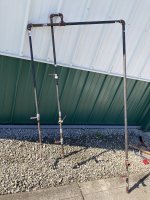bigtiller
Super Member
- Joined
- Feb 1, 2006
- Messages
- 7,301
- Location
- central Iowa
- Tractor
- John Deere 2720 John Deere 3039R John Deere Z545R
To help cool the hot vapors from the tank into larger and cooler droplets that the water filter can remove, I coiled a 25' long, half inch I.D. hose on the cool concrete floor between the tank outlet and the regulator/filter inlet. That works for me, but I don't paint. My regulator/filter is a RapidAir with a ¾" inlet and a 5 micron filter.
I also have an auto-drain on the 60 gallon tank that I have set to blow the condensate out for 3 seconds every 6 hours.
When I mow the yard on the most humid days in August, I get dry air from the hose while blowing all the grass chaff off of me.
Before this setup, I could get enough moisture out of the blowgun to make my shirt feel wet after blowing off the grass.
I also have an auto-drain on the 60 gallon tank that I have set to blow the condensate out for 3 seconds every 6 hours.
When I mow the yard on the most humid days in August, I get dry air from the hose while blowing all the grass chaff off of me.
Before this setup, I could get enough moisture out of the blowgun to make my shirt feel wet after blowing off the grass.
Last edited:
